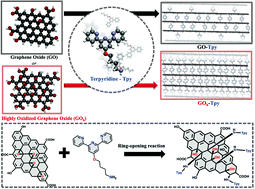High-sorption terpyridine–graphene oxide hybrid for the efficient removal of heavy metal ions from wastewater†
Abstract
Pollution of wastewater with heavy metal-ions represents one of the most severe environmental problems associated with societal development. To overcome this issue, the design of new, highly efficient systems capable of removing such toxic species, hence to purify water, is of paramount importance for public health and environmental protection. In this work, novel sorption hybrid materials were developed to enable high-performance adsorption of heavy metal ions. Towards this end, graphene oxide (GO) exhibiting various C/O ratios has been functionalized with ad hoc receptors, i.e. terpyridine ligands. The maximum adsorption capacity of highly oxidized/terpyridine hybrids towards Ni(II), Zn(II) and Co(II) was achieved at pH = 6 and 25 °C reaching values of 462, 421 and 336 mg g−1, respectively, being the highest reported in the literature for pristine GO and GO-based sorbents. Moreover, the uptake experiments showed that heavy metal ion adsorption on GO–Tpy and GOh–Tpy is strongly dependent on pH in the range from 2 to 10, as a result of the modulation of interactions at the supramolecular level. Moreover, the ionic strength was found to be independent of heavy metal ion adsorption on GO–Tpy and GOh–Tpy. Under ambient conditions, adsorption capacity values increase with the degree of oxidation of GO because dipolar oxygen units can both interact with heavy-metal ions via dipole–dipole and/or ionic interactions and enable bonding of more covalently anchored terpyridine units. Both adsorption isotherms and kinetics studies revealed that the uptake of the heavy metal ions occurs at a monolayer coverage, mostly controlled by the strong surface complexation with the oxygen of GO and nitrogen-containing groups of terpyridine. Furthermore, selectivity of the hybrid was confirmed by selective sorption of the above heavy metal ions from mixtures involving alkali (Na(I), K(I)) and alkaline Earth (Mg(II), Ca(II)) metal ions due to the chelating properties of the terpyridine subunits, as demonstrated with municipal drinking (tap) water samples. Our findings provide unambiguous evidence for the potential of chemical tailoring of GO-based materials with N-heterocyclic ligands as sorbent materials for highly efficient wastewater purification.



 Please wait while we load your content...
Please wait while we load your content...